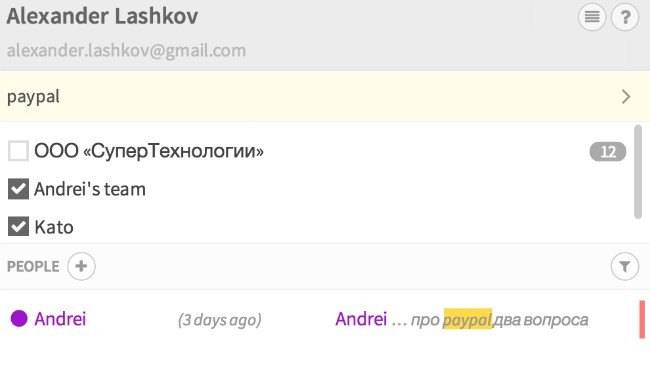Fighting Information Noise in a Big Company: Introducing the Twitter Approach to the Messenger

One of the main advantages of email, thanks to which it is a standard in corporate communications (despite certain disadvantages of this technology ) is the simplicity and efficiency of communication organization, even in large companies.
It has not yet been possible to replace it with other tools, largely due to the limitations that are imposed on communication - often you cannot get access to the right people without the need to put up with information overload. As a result, within a specific team of employees, any means of communication can be used, but the entire company is entirely connected by e-mail.
')
When working on the Kato.im messenger for corporate communications , we paid much attention to the problem of reachability of the interlocutors and reducing the amount of information noise.
Twitter against noise
Despite the image of a very “noisy” social network, Twitter has a very thoughtful and effective system to reduce the likelihood of stumble upon irrelevant information. The mechanism of subscription to messages from specific users and lists allows people to form their own tape so that it meets their needs - if someone from the users becomes too "noisy" or starts to publish spam, it is very easy to unsubscribe from it. This completely removes his tweets from the tape.

A similar approach was introduced in Kato - in a large company consisting of thousands of employees, there may be a large number of divisions, projects and internal chats (“commands” and “rooms” in Kato terminology). The user may not need all this information, so we decided to give him the opportunity to “subscribe” to the necessary rooms in order to receive information about the most relevant discussions for him.
At the same time, there is another remarkable element on Twitter - mention. To attract the attention of the desired user, it is not necessary to be signed up to it (or for this user to be subscribed to the interlocutor). It is only necessary to mention in the tweet his username - @ username - and he will be able to see this tweet.
In Kato, there is no “presence” model of the user in one or another conversation. In order to attract the attention of the right person, you can simply mention it (like on Twitter) and regardless of the subscription level, he will see the message.

Kato's approach implies the absence of a hard link between the individual and the room — if an employee is mentioned in a room in which he had not previously participated, he can open it immediately and enter into a discussion.
This approach is fundamentally different from other instant messengers, where in order for the addressee to see a message in a room in which it is not present, it must first be added to it in some way or this user must request access himself.
Such a scheme does not scale well, because ultimately either a situation arises in which “everything is in all rooms” or people will have to constantly enter the necessary rooms and leave them after solving the problem in order not to suffer from information noise. At the same time, if a person leaves the room, in order for him to be able to respond to new messages, the interlocutors will be asked to invite him again to the room.
Such a forced membership in a particular group has nothing to do with how communication is built in real life — the subscription mechanism and mentions are more organic and work much more efficiently.
Scaling communications
Another problem that arises when using instant messengers is their narrow “bandwidth”. As a rule, these tools do not allow you to easily participate in a large number of discussions without changing the context - usually the user has to deal with one conversation (room or team) per unit of time and switch the context to participate in another discussion.
An analogy with the concept of “bus” is appropriate here - the more people there are, the more bus bandwidth is required, only in this way they will be able to effectively “pump” all their conversations.
The “high cost” of the process of switching the context from room to room makes the use of chats in working communication practically useless. Therefore, in Kato, we have implemented the possibility of light work in many rooms and even teams at the same time.
A simple example of a user who needs this opportunity is a project manager in a large company. This specialist is forced to communicate with different teams of developers, testers, designers, and conversations on various topics can take place simultaneously. If he needs to constantly switch between conversations and spend time on it, this will dramatically reduce the quality of communications and, as a result, management.
It is very important to have one communication “bus” for the entire company, but if within the same organization there is a zoo for chat programs used by different teams, this will only contribute to the fragmentation of communication data and slow down the process of information exchange.
In addition, very often in companies there is a need to process a large number of automatically generated messages (commit messages, server status alerts, new purchase data in an online store, etc.). Usually, in messengers, users are forced to either send these messages to the main team communication room (to guarantee their visibility) or create a separate room for them (which no one will read, because constantly switching is not very convenient).
Since Kato allows users to be in multiple rooms at once and see everything that happens in them, the problem of automatic messages is solved very simply. We recommend not to send these messages to the rooms where people communicate, but to create integration for the room (or for the type of information - code, finance, statistics, etc.). This allows team members to flexibly customize their acceptable noise level.

Broadcast communication
In large companies, where thousands and even tens of thousands of employees work, many people may not know each other personally, but despite this, they have to communicate with each other. For example, in a situation when there was a technological failure, an employee whom he interferes needs to contact the support department.
To do this, he does not need to know the names of specific engineers - usually he simply writes an email to a public address, such as
support@companyname.com , and the currently available specialist begins to deal with his problem. In Kato, a similar possibility of “broadcasting” communication of one person with the whole team is realized.In order for the message to be noticed by the employees of the required department, you need to mention the name of the room that unites this department (for example, the same Support). Thus, if there is a discussion of any topic, where someone from the necessary department should be involved, it is very convenient to “call” on the profile specialists without the need to know their names.
Such rooms serve as a kind of buffer between the team responsible for a certain range of tasks and the personalities included in it.
Team members may also have an agreement on who and how should respond to references to rooms that other employees turn to in emergency situations. Accordingly, if upon the occurrence of such a situation, for some reason, mentioning a room does not entail a reaction from the responsible employees, then it makes sense to raise the question of the quality of the organization of work processes in their team.
The importance of the search
A common problem in instant messengers is also an extremely difficult search for the necessary information. A person who participates in many discussions cannot easily find the necessary data or file in the message history. Instead, he must first open the desired chat, and then use ctrl + f to search the history, loading it up to the “victorious end”.
In Kato, we solved this problem by implementing a general search on all chats, as in email - the user enters the necessary keywords, and sees the chats in which they were used.

That's all, thank you for your attention. In the upcoming materials we will talk about Kato architecture and how the integration of the messenger with third-party services is organized.
Source: https://habr.com/ru/post/244975/
All Articles